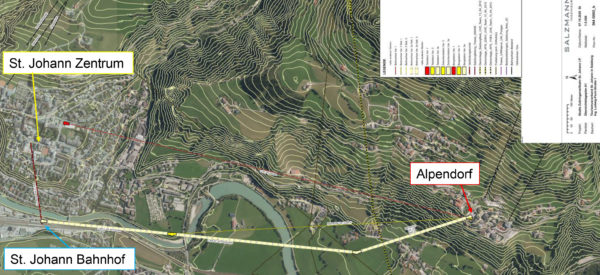
Cities, SI Urban 1/2021, Tourism
“A trial balloon for the big solution!”
SI Urban: Mr Salzmann, as a cable car planner for many years, you have great experience in the planning, construction and operation of cable cars. When do urban tourist cable cars make sense?
Stephan Salzmann: There are three reasons for this type of cable car: first, the town already has a tourist attraction, such as on a mountain, on an island or on the other side of a stretch of water, or the town has an undeveloped location with great tourist potential; second, at present, the route to it can be covered only slowly, inconveniently or with a negative effect on the surroundings; and third, the panorama makes journey to the excursion destination an experience in its own right.
What can an urban tourist cable car achieve?
A cable car can channel the flow of visitors – in both directions. It can be the stimulus for more guests or limit the flow to overcrowded destinations. Not least, the tourist cable car can also be a trial balloon for the big solution, i.e. for everyday urban cable cars, as excursion lines are a means to place the cable car in people’s minds as a mode of transport.

Interview
The cable car in St Johann will connect the town centre (St Johann Zentrum) to the railway station (St Johann Bahnhof) and the tourist district of Alpendorf. Photo: SALZMANN
So what needs to stick in people’s minds?
People need to understand that the respective cable car is viable and makes sense. The cable car must do more than provide access to places that already work – or have the potential to work – as attractions. It must improve the present situation, i.e. it must trigger a pull effect on tourists but at the same time reduce car traffic or make the destination accessible for people with impaired mobility.
The route should be spectacular, the transport capacity adequate, and the operating costs and finance acceptable. Even the right energy mix can contribute to stronger acceptance of this mode of transport – which is already inherently environmentally friendly. Not least, the image effect of a cable car should play a part in the public discussion.
Which technical questions need to be answered?
To find the right cable car system, you have to know which and how many passengers need to be transported, how many tourists the destination can handle and for how long they are expected to stay. Chairlifts are fundamentally unsuitable, as an urban tourist cable car needs to run regardless of the weather and to transport wheelchair users, pushchairs and bicycles.
Circulating cableways, aerial tramways and funicular railways are therefore the systems of choice – depending on the planned transport capacity and topography. Aerial tramways have the advantage of lower operating costs, as they run only at intervals and require few supports. By contrast, circulating cableways can transport people continuously and with no waiting times.
Those who want a very high transport capacity, need to run along winding routes and have level terrain can use a funicular railway, but that is generally the most expensive solution.
What needs to be considered in the urban context?
The cable car must not be considered in isolation. Connection to the public transport system and a well- thought-out parking concept are essential, in order to get local residents on board. In general, a tourist cable car route should avoid heavy development.
I advise the people responsible at cable car planning companies like ours to have a requirement profile created with a study of alternatives. Affected neighbours and landowners should then be involved at the earliest possible stage and public interest should be generated through civic participation. Only then should a feasibility study be undertaken, in which we can seriously estimate the costs.
How does this approach look in practice?
One best practice example is the Austrian tourist destination of St Johann. My planning company recently conducted a feasibility study for the Alpine town. The objective is an urban tourist cable car between the town centre of St Johann, the railway station and the tourist district of Alpendorf.
We produced four routes for this, with conveniently situated start and destination locations, and we examined these in terms of cable car and safety technology as well as legal feasibility. It was demonstrated here that the most cost-effective, direct option over a built- up area is not feasible, for legal and political reasons.
Two other routes with a direct connection to the railway station and possible development of a conveniently located car park are significantly more realistic. Because a cable car must not be considered in isolation, as I said, we produced combination options. An additional cable car section or a pedestrian tunnel is therefore being considered, to connect the town centre and the railway station.
What does St Johann want from the cable car?
The cable car should provide holistic benefit. Safe and convenient connections for passengers and high availability of the mode of transport take priority. Other major objectives include: the promotional function for the town and the ski resort, with a direct connection to the railway station; relief for the traffic and parking situation in and around St Johann; and making the entire hotel and restaurant industry more attractive.
But how can a cable car like this be funded?
Primarily from ticket sales. An urban tourist cable car should at least break even in operation, but a cable car can be a useful facility even if it makes a loss, if it makes the town more attractive to tourists and thus boosts the local economy. Public-private partnership models and the participation of stakeholders, such as the restaurant industry, could offer financing solutions for the investment costs.
To what extent could tourist cable cars now be a blueprint for urban cable cars?
There is little difference between excursion lines and urban systems. On tourist lines, the operating hours might be shorter and the journey times longer, in order to enjoy the view more, or large panoramic windows might be installed.
Urban cable cars, by contrast, might have tinted windows for greater privacy. The stations might also be staged differently and contain a supermarket rather than a souvenir shop. Otherwise, the experience and concept are easily transferrable.
The interview was conducted by Thomas Surrer (ts)







